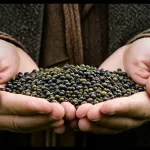Understanding Spotted Dick and Its Texture
Spotted dick is a traditional dessert known for its distinctive texture, which results from the combination of specific ingredients and preparation methods. This classic British pudding is famous for its moist and dense characteristics, heavily influenced by the key ingredients used in its making.
The texture analysis of spotted dick reveals the importance of ingredients like suet and flour, which contribute significantly to the dessert’s structure. Suet, a type of animal fat, is integral for achieving the rich and moist texture that is characteristic of spotted dick. It melts slowly during the cooking process, allowing the pudding to remain tender. Flour, on the other hand, provides the necessary framework that supports the pudding’s shape and complements the suet’s fat content. In addition to these core ingredients, dried fruits such as currants or raisins add both flavor and a unique touch to the pudding’s overall feel.
Also to see : How Can British Cuisine Transform with Modern Cooking Techniques?
Understanding these elements and their role in texture can help cooks recreate the traditional experience of enjoying this beloved dessert. Variations in preparation, such as substituting suet with vegetarian fats or altering the fruit combination, can lead to slight changes in texture, allowing for personalization while retaining the conventional essence of spotted dick.
Recommended Ingredients for Ideal Texture
To achieve the ideal texture for spotted dick, mastering the use of specific ingredients is crucial. Traditional recipes firmly anchor themselves in using suet and flour as the core elements. Suet, an animal fat, is indispensable for creating a moist and airy density. It slowly melts during steaming, imparting richness and retaining moisture. Flour counterbalances this by providing the necessary structure to hold the pudding together, ensuring it remains firm yet tender.
This might interest you : How can you prepare a flavorful Lancashire hotpot at home?
In cases where alternative ingredients are desired, such as using vegetable-based fats for a vegetarian version, these substitutions can influence the pudding’s texture. While the essence of spotted dick remains, the resulting texture can vary, offering a different but delightful experience. For instance, using margarine or butter can lead to a slightly softer texture, accommodating dietary preferences without sacrificing taste.
Moreover, incorporating a variety of dried fruits like cranberries or apricots alters the texture further, adding bursts of flavor and chewy elements. These variations allow for creativity and personalization, enabling cooks to adapt the recipe while still honoring the traditional method. Keeping a balance in ingredients ensures that the texture remains appealing, whether sticking to the classic or venturing into modern adaptations.
Preparing Spotted Dick: Step-by-Step Guide
Preparing spotted dick involves a series of precise cooking techniques that ensure the traditional texture is achieved. Here’s a step-by-step guide to help you successfully make this beloved British dessert.
Begin by gathering all ingredients. It’s essential to precisely measure each component for maintaining the desired texture. Mix the suet and flour together in a large bowl, ensuring they are well combined to form the batter’s base. This mixture provides the pudding’s structure and richness. Add the remaining ingredients, including sugar and dried fruits, then blend thoroughly until you have a uniform batter.
Shaping the batter is crucial for optimal steaming. Transfer it to a pudding basin, pressing gently to ensure there are no air pockets. Cover the basin with a double layer of buttered baking paper and foil, securing them tightly with string to prevent water from entering during the cooking process.
For the cooking method, steaming is preferred to achieve a moist and dense texture. Fill a large pot with water, ensuring the pudding basin is elevated above the water line on a trivet. Cover the pot with a lid and steam for about two hours, verifying the water level occasionally.
Keep the steaming process even by maintaining a consistent simmer. This is key for preventing any regions of the pudding from becoming soggy or burnt, ensuring a uniform cook throughout. After steaming, let the pudding cool slightly before serving it to allow the flavors to meld together, offering a delightful dining experience.
Cooking Techniques for Texture Enhancement
Proper cooking methods significantly influence the texture of spotted dick, ensuring that this traditional dessert remains a delightful treat. While both steaming and baking can be used, steaming is often recommended for achieving the ideal moist and dense texture, characteristic of classic spotted dick. Steaming allows for gradual and even heat distribution, which is crucial to preventing overcooking and ensuring the pudding retains its rich and tender qualities.
Benefits of Steaming Versus Baking
-
Steaming creates a more uniform texture by preventing the dessert from drying out. This method helps in maintaining the pudding’s moisture, a hallmark of the traditional spotted dick.
-
Baking can be an alternative for those who prefer a slightly firmer texture. However, precautions should be taken to avoid overcooking, which can lead to a dense and dry outcome.
Recommended Cookware and Setup for Steaming
For optimal results, utilize a pudding basin and a large pot or steamer. Elevate the pudding above the water using a trivet, ensuring it is not submerged. This setup helps maintain consistent simmering, which is vital for an even cook.
Techniques for Ensuring Even Cooking and Preventing Sogginess
Maintain a steady simmer to ensure consistent temperature throughout the steaming process. Regularly check the water level to prevent it from dropping too low or overflowing the pudding basin. This vigilance, along with the use of a tight cover for the basin, prevents water from entering and making the dessert soggy. Achieving and maintaining these conditions guarantees a texture that is both velvety and delectable.
Troubleshooting Common Texture Issues
When working with spotted dick, it’s crucial to be aware of potential texture issues that may arise. Common mistakes can lead to a dense or dry texture, but understanding how to troubleshoot these problems can ensure a delightful result.
Identifying and Resolving Common Issues
-
Density and Dryness: If the pudding turns out too dense, it might be due to insufficient suet or an overabundance of flour. Conversely, dryness often results from overcooking or not enough suet being used. Adjusting the ratio of suet to flour can solve these problems effectively.
-
Sogginess: Check for proper steaming techniques. Ensuring the cover is tight during steaming prevents excess moisture from seeping into the pudding, causing sogginess.
Adjustments in Ingredient Ratios and Cooking Time
Achieving the perfect texture often requires fine-tuning ingredient ratios. A heavier hand with suet, for example, will generally yield a more moist result. Likewise, careful attention to cooking time is essential; over-steaming leads to a dry dessert, while under-steaming may result in a soggy or undercooked outcome.
Importance of Checking for Doneness
To test for the right texture, insert a skewer into the pudding—if it comes out clean, it’s done. Employing such doneness tests helps in discerning the correct moment to end cooking, thereby achieving the desired outcome.
Understanding these details ensures any texture-related issues are swiftly resolved, helping you create a delicious and satisfying treat every time.
Variations and Modern Twists on Spotted Dick
Modernizing the traditional spotted dick involves thrilling recipe variations that enrich its classic essence with fresh flavors and textures. Enthusiasts can explore these adaptations to breathe new life into this much-loved traditional dessert.
Exploring Contemporary Adaptations
Contemporary takes on spotted dick often incorporate a broader range of fruits or flavorings. For instance, adding citrus zest or incorporating spices like nutmeg or cinnamon can transform the dessert into a more vibrant dish. Adjusting dried fruit choices to include apricots or cherries can also introduce unique textures and unexpected bursts of flavor, offering a delightful twist on the conventional recipe.
Incorporating Different Fruits or Flavorings
Experimenting with various fruits can significantly influence both taste and texture analysis. Utilizing fruits such as cranberries or figs can add tanginess and a chewy texture to the pudding. Flavorings like vanilla or almond extract can enhance the dish’s depth, providing layers of flavor while still respecting its traditional roots.
Suggestions for Serving Methods and Accompaniments
To elevate the serving experience, consider pairing modern recipes of spotted dick with accompaniments that complement its rich taste. Custards, crème anglaise, or simple dollops of fresh cream can accentuate the dessert’s lush texture. Additionally, serving it warm ensures that the complex flavors blend harmoniously, presenting a compelling take on this classic British favorite.







